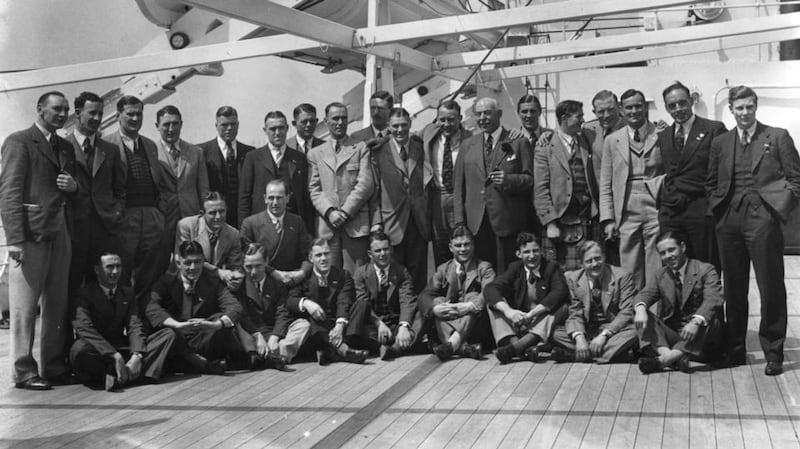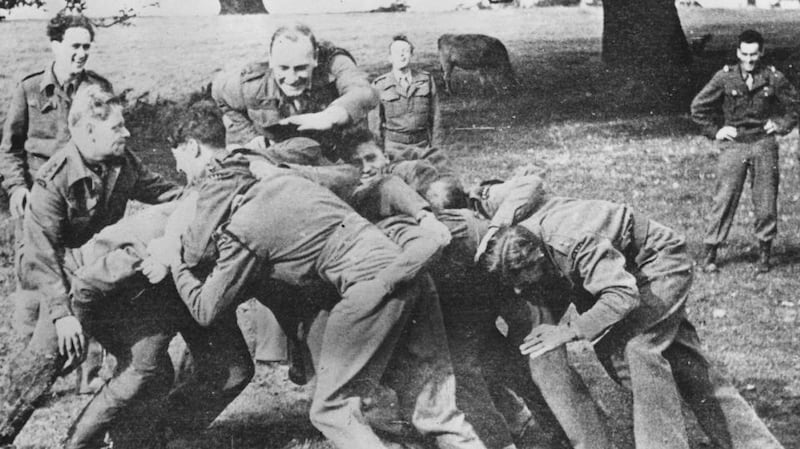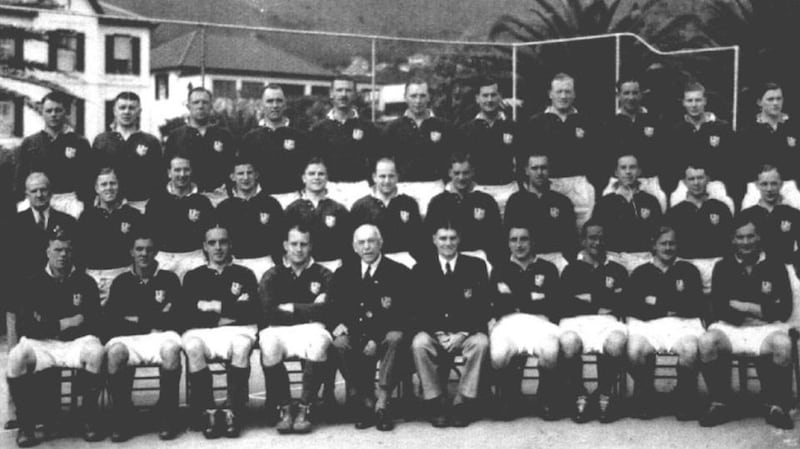In May 2019, it emerged that the creator of Peaky Blinders is adapting the story of the birth of the Special Air Service as a television drama. Here, John O'Sullivan examined the life and times of Col Robert Blair "Paddy" Mayne - an original member of the service and an Irish rugby international with a reputation as a hard-drinking, free-swinging firebrand.
It was 3am. The Rev George Cromey had recently extinguished a bedside light when the door to the room splintered. Peering through the darkness he recognised the towering figure of Robert Blair “Paddy” Mayne, framed in the threshold, wearing a white dress suit, cummerbund and a broad grin, with what appeared to be a dead Springbok draped over his shoulders.
Seconds later down the corridor another door was forcibly unhinged as Mayne surprised Lions captain Sammy Walker, an Ulster and Ireland team-mate, throwing the lifeless carcass on to the bed. Returning from an official function in Pietermaritzburg, Mayne spotted some locals and took off for an impromptu lamping session, returning in the wee hours with his bounty.
The dead animal “visited” several more rooms on the premise that a couple of the players had complained that the meat in South Africa wasn’t quite as fresh as back home. One of which belonged to England wing Jim Unwin and in the commotion, played out in darkness, Unwin gored his leg while extricating himself from beneath Springbok and bedclothes, missing a couple of matches as a result.
Mayne then climbed on to a ledge outside the room of the South African rugby team manager and left the Springbok impaled on railings with a note that read: “a gift of fresh meat from the British Isles touring team”.
It’s just one of a hundred vignettes from the 1938 Lions tour to South Africa involving the 23-year-old Mayne from Newtownards, a man who would go on to become among the most decorated soldiers in the second World War, an original member of the then newly formed SAS (Special Air Service), founded by David Stirling and after the latter’s imprisonment in Colditz, the commanding officer of the SRS (Special Raiding Squadron) and then 1st SAS.
Mayne set an unimpeachable benchmark as a hard-drinking, free-swinging firebrand, even by rugby’s generously broad parameters of horseplay, schoolboy pranks and questionable behaviour. It was a lifestyle choice that refused to be constrained or tempered by army life to boot.
The son of William Mayne and Margaret Boyle Vance, he was born in January 1915, the sixth of seven children, four boys and three girls, who grew up on the 41-acre grounds of the Mount Pleasant estate overlooking the town. Educated at Regent House School, he played cricket, rugby and golf, excelling in each while also demonstrating an aptitude as a marksman in the rifle club.

While at Queen’s in Belfast studying law, he took up boxing and within a matter of months won the Irish Universities Heavyweight title in August 1936. He made his Ireland rugby debut against Wales at Ravenhill in 1937 and the last of six appearances two years later, coincidentally against the same opposition in Belfast.
His talent was recognised in selection for 1938 Lions tour to South Africa, where he made quite an impression on and off the pitch. Mayne could tolerate any physical challenge but was unable to cope with boredom and when of a mind to do something expected full compliance from acolytes, willing or reluctant.
Years later, the late Jack Kyle recalled being carried into and out of bars, under Mayne’s arm if necessary when reticent to continue the evening’s libations at a different hostelry.
On the 1938 Lions tour, Mayne had a penchant for reducing room furniture to kindling, as was the case when team-mate Harry McKibbin refused to “come out to play” one afternoon or to make a point when “the blazers” were given far superior rooms to the players in one particular hotel during that tour of South Africa.
The young Irishman did encounter the odd like-minded soul, one in particular Newport-born Wales hooker William “Bunner” Travers.
When the Lions reached the famous Ellis Park, stands were in the process of being erected by convicts from a local prison who slept in a compound beneath the scaffolding. Mayne and Travers engaged one convict in conversation asking what he had done to be imprisoned. The answer was stealing chickens for which he got seven years.
The Lions’ players christened their new friend “Rooster” and decided to help him and a friend fly the coop. That night Mayne and Travers returned with bolt cutters and clothing and set free the convicts.
Unfortunately for Rooster and his buddy they were recaptured within 24-hours and their accomplices were revealed in papers found in the jackets they were wearing at the time. Mayne would disappear occasionally during the tour, once prior to a game against Natal, for a 24-hour drinking spree with a local farmer. It didn’t compromise his influence on the pitch throughout the tour as chronicled in numerous newspaper accounts, singling him out as an outstanding player.
His friend and captain Sammy Walker intervened on perhaps half a dozen occasions when the consensus appeared to be that Mayne should be sent home. Tour manager Major Jock Hartley relented because he understood the importance of the Irishman to the team.
Mayne was alleged to have repaid his debt during one particular match that contained several scurrilous incidents, one of which left Walker seeing stars. As he regained consciousness he saw two stretcher-bearers run straight past him to where a giant South African lay motionless. Walker looked up to see Mayne smiling down, saying: “Don’t worry Sammy it’s sorted.”

In a bid to calm his antics, Mayne was asked to share a room with the aforementioned Rev George Cromey, a fellow Ulsterman, Irish international, Queen’s University graduate and a Presbyterian minister.
Cromey, who played outhalf in one of the tests, wrote in his diary entry for Saturday, August 30th, 1938, after beating Border 19-11: “Blair Mayne drinking a lot of lemonade and barley water – great.”
It wasn’t habitual because soon after Cromey was mid-sermon at an ecumenical sports service when he was distracted by the sound of snoring, Mayne the culprit after another hard night.
His off-pitch exploits couldn’t camouflage his innate ability as a player. Mayne lined out in 17 of the 20 provincial games and all three tests against the Springboks; having lost the first two he was singularly influential in securing a victory for the Lions in the third test.
The late Sean Diffley, rugby correspondent and author, wrote of the secondrow: “Mayne was a Viking, a throwback to the ancient days of towering warriors, gentle and charming when in repose, but fierce and dangerous when aroused, and a ‘hyphenated’ nuisance when he had a couple of jars.
“His fierce dark physical outbursts may well have been the stuff of legend, but they were not always fun to those immediately concerned, and they were a great cause of worry to his friends.
“There was the case of the Irish player for instance, who in 1939, was thrown out of the window of the Swansea hotel by Mayne during the post-match celebrations. Witnesses were thankful that it was a ground floor window and that the player came to no harm, but it was not simply high jinx either that caused the incident, but the result of Mayne brooding darkly on something that is now long forgotten.”
At the outbreak of the second World War, Mayne received a commission in the 5th Anti-Aircraft Battery, in April 1940 joined the Royal Ulster Rifles and following Dunkirk volunteered for the 11 (Scottish) Commando.
He was mentioned in dispatches for the impressive manner in which he commanded his troop in the Litani River Raid in Lebanon and recruited by David Stirling for his newly formed SAS unit.
There is a story that Mayne was in prison and awaiting a court-martial for striking his commanding officer, Geoffrey Keyes, later posthumously awarded a Victoria Cross, but whom the Irishman considered an upper-class twit. Mayne had no time for the privileged caste.
Gavin Mortimer, a highly regarded author who has written several books on the SAS among others – he was a consultant for the recent BBC three-part series on the wartime SAS and another, Fields of Glory, which includes a compelling account of Mayne, person, player and soldier – disputes the notion.
“There is no record of Mayne’s arrest and Stirling was prone to exaggerate.” He offered an insight into Mayne’s character, gleaned from conversations with those who fought alongside the big Irishman.
“Paddy Mayne was socially awkward with no idea how to talk to women even though they were attracted to this very big, athletic man. He revered his mother and put women on a pedestal, refusing to tolerate swearing in their presence.
“He was shy until drink initially loosened his inhibitions but then transported him to far darker places . . . Mike Sadler recounts the time that while sitting in a restaurant in Paris surrounded by seven or eight soldiers Mayne took out a grenade, pulled the pin and placed it on the table. Several dived for cover but Sadler reckoned that Mayne wasn’t about to kill himself. He was right; Paddy had previously removed the detonator.”

Mortimer explained that the men who served with Mayne had a huge respect and admiration, drawing from his comforting presence on missions, but he had no close friends, other than Eoin McGonigal, who helped persuade him to join the SAS and who was killed in the Benghazi raid, the very first SAS operation in 1941.
He cut a solitary figure, often to be found reading the darker poetry of AE Housman. He wasn’t reckless with the lives of his men. He weighed up situations, was intuitively brilliant in terms of the guerilla tactics he employed when orchestrating his night-time raids in customised jeeps deep behind enemy lines initially in Egypt and Libya.
Mayne and his troops also saw action in Sicily, the Italian mainland, France working alongside the Maquis, Holland, Belgium and Norway, but it was in Germany near the town of Oldenburg that his legend grew further.
After the squadron became pinned down and sustained casualties, Mayne rescued the wounded, lifting them one by one from a ditch and into his jeep before destroying the enemy gunners in a nearby farmhouse.
Field Marshal Bernard Montgomery signed a citation advocating a Victoria Cross but it was subsequently downgraded to a fourth DSO to go alongside numerous other honours that included being the first foreigner to be awarded the legion d’honneur and croix de guerre medals.
George VI publicly expressed surprise that Mayne had not been awarded a Victoria Cross. In 2005, 50 years after Mayne’s death, an Early Day Motion in the House of Commons supported by 100 MPs, proposed that, “the Government mark these anniversaries by instructing the appropriate authorities to act without delay to reinstate the Victoria Cross given for exceptional personal courage and leadership of the highest order and to acknowledge that Mayne’s actions on that day saved the lives of many men and greatly helped the allied advance on Berlin.” It was defeated.
Mayne sought further adventure in an Antarctic expedition but had to return home prematurely with a debilitating back condition, the origins of which came from his war service.
He took up a position as secretary to the Law Society of Northern Ireland until, returning from a night’s socialising on December 13th, 1955, he clipped an unlit parked lorry, and crashed into a telegraph pole on the Scrabo road, a few hundred metres from his house. He died aged 40 and is buried in Movilla Abbey graveyard.
Hundreds attended his funeral. His life is commemorated in books, film and a statue in his native Newtownards. The town’s western bypass is also named after him.
A remarkable and complex character, he crammed a great deal into a life largely spent in the service of others, some of whom would have regarded him as a hero, although he, himself, would not.


















